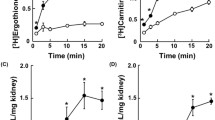Abstract
In order to study the characteristics of contraluminal para-aminohippurate transport into proximal tubular cells the stopped flow capillary perfusion method was applied. The disappearance of3H-paraaminohippurate from the capillary perfusate at different concentrations and contact times was measured and saturation type behaviour was found with aK m of 0.08±0.01 (SE) mmol/l,J max of 1.1±0.1 pmol·s−1·cm−1 andr, the final extracellular/intracellular distribution ratio of 0.93±0.03. Omission of Na+ from the capillary test perfusate caused a small reduction of contraluminal PAH uptake at small transport rates (0.1 mmol/l PAH in the test perfusate) but not at high transport rates (1.0 mmol/l PAH in the test perfusate). Change of K+ between 0 and 40 mmol/l and pH between 6.0 and 8.0 did not influence contraluminal PAH uptake. Isotonic replacement of chloride by gluconate, nitrate, sulfate, phosphate, methanesulfonate or increase in bicarbonate to 50 mmol/l did not influence PAH uptake at small transport rates. But isotonic sulfate and phosphate, as well as 50 mmol/l HCO −3 and 25 mmol/l Hepes in isotonic solutions reduced PAH uptake at high transport rates. Addition of 5 mmol/l Ca2+, Mg2+, Mn2+, Ba2+, Cd2+ to isotonic Na+-gluconate solution did not influence PAH uptake except for Mg2+ and Mn2+ which inhibited uptake at small transport rates only. Preperfusion of the peritubular capillaries with rat serum, Na+ gluconate (Ca2+-+Mg2+-free), Na+ gluconate (Ca2+-+Mg2+-free) plus 10 mmol/l lactate or pyruvate or 0.1 mmol/l 2-oxoglutarate did not influence PAH uptake at small PAH transport rates, but inhibited at high transport rates. Preperfusion of the capillaries for 10 s with Na+-, Ca2+- and Mg2+-free solutions reduced PAH uptake in the presence of Na+ at both transport rates. A second 10 s preperfusion — after the first 10 s Na+-, Ca2+-, Mg2+-free preperfusion — with serum or solutions which contained Na+ and Ca2+ or Mg2+ restored the PAH fluxes to control values. The data are compatible with the hypothesis that contraluminal PAH uptake occurs by a saturable transport mechanism in exchange for other intracellular anions rather than in cotransport with Na+ ions. It was, however, not possible to identify the type of counteranions involved. The large effect of cation replacement on para-aminohippurate transport, which was reported in many previous studies with kidney slices, is not a direct effect on the para-aminohippurate transporter, but is rather caused indirectly via cell metabolism and/or changed ion gradients.
Similar content being viewed by others
References
Berner W, Kinne R (1976) Transport of p-aminohippuric acid by plasma membrane vesicles isolated from rat kidney cortex. Pflügers Arch 361:269–277
Burckhardt G, Moewes B, Shimada H (1987) Energetization of PAH uptake across the basolateral membrane of proximal tubular cells. Pflügers Arch 408 (Suppl):R39
Fritzsch G, Haase W, Rumrich G, Fasold H, Ullrich KJ (1984) A stopped flow capillary perfusion method to evaluate contraluminal transport parameters of methylsuccinate from interstitium into renal proximal tubular cells. Pflügers Arch 400:250–256
Gerencser GA, Park YS, Hong SK (1973) Sodium influence upon the transport kinetics of p-aminohippurate in rabbit kidney slices. Proc Soc Exp Biol Med 144:440–444
Häberle DA (1981) Characteristics of p-aminohippurate transport in the mammalian kidney. In: Greger R, Lang F, Silbernagl S (eds) Renal transport of organic substances. Springer, Berlin Heidelberg New York, pp 189–209
Hayashi H, Hoshi T (1979) Sodium-dependence of p-aminohippurate transport by rat kidney cortex slices. Arch Int Pharmacodyn Ther 240:103–115
Hayashi H, Hoshi T (1982) Effect of potassium on p-aminohippurate transport in rat kidney cortex slices. Renal Physiol 5:10–17
Hori M, Gemba M (1985) Effect of barium ion on p-aminohippurate transport in basolateral membrane vesicles isolated from rat kidney cortex. Arch Int Pharmacodyn Ther 275:287–299
Kasher JS, Holohan PD, Ross CR (1983) Na+ gradient dependent p-aminohippurate transport in rat basolateral membrane vesicles. J Pharmacol Exp Ther 227:122–129
Kikuta Y, Hoshi T (1979) Role of sodium ions in p-aminohippurate transport by newt kidney. Biochim Biophys Acta 553:404–416
Kinsella JL, Holohan PD, Pessah NI, Ross CR (1979) Transport of organic ions in renal cortical luminal and antiluminal membrane vesicles. J Pharmacol Exp Ther 209:443–450
Maxild J, Møller JV, Sheikh MI (1981) An energy-dependent, sodium-independent component of active p-aminohippurate transport in rabbit renal cortex. J Physiol 310:273–283
Maxild J, Møller JV, Sheikh MI (1981) Involvement of (Na++K+)-ATPase in p-aminohippurate transport by rabbit kidney tissue. J Physiol 315:189–201
Podevin RA, Boumendil-Podevin EF (1977) Monovalent cation and ouabain effects on PAH uptake by rabbit kidney slices. Am J Physiol 232:F239-F247
Sheikh MI, Moller JV (1982) Na+ gradient-dependent stimulation of renal transport of paraaminohippurate. Biochem J 208:243–246
Sheikh MI, Møller JV (1983) Nature of Na+-independent stimulation of renal transport of p-aminohippurate by exogenous metabolites. Biochem Pharmacol 32:2745–2749
Tse SS, Bildstein CL, Liu D, Mamelok RD (1983) Effects of divalent cations and sulfhydryl reagents on the paraaminohippurate transporter of renal basal lateral membranes. J Pharmacol Exp Ther 226:19–26
Ullrich KJ (1974) Recent progress in renal physiology: Transport of hexoses, amino acid, phosphate and paraaminohippurate in the proximal tubule. Lettura della “Fondazione Bottazzi”. Ital Soc of Physiol, Riva del Garda, pp 1–26
Ullrich KJ (1976) Renal tubular mechanisms of organic solute transport. Kidney Int 9:134–148
Ullrich KJ, Capasso G, Rumrich G, Papavassiliou F, Klöss S (1977) Coupling between proximal tubular transport processes. Studies with ouabain, SITS and HCO −3 -free solutions. Pflügers Arch 368:245–252
Ullrich KJ, Fasold H, Rumrich G, Klöss S (1984) Secretion and contraluminal uptake of dicarboxylic acids in the proximal convolution of rat kidney. Pflügers Arch 400:241–249
Ullrich KJ, Rumrich G, Klöss S (1984) Contraluminal sulfate transport in the proximal tubule of the rat kidney. I. Kinetics, effects of K+, Na+, Ca2+, H+ and anions. Pflügers Arch 402:264–271
Ullrich KJ, Rumrich G, Fritzsch G, Klöss S (1987) Contraluminal paraaminohippurate (PAH) transport in the proximal tubule of the rat kidney. II. Specificity: Aliphatic dicarboxylic acids. Pflügers Arch 408:38–45
Author information
Authors and Affiliations
Rights and permissions
About this article
Cite this article
Ullrich, K.J., Rumrich, G., Fritzsch, G. et al. Contraluminal para-aminohippurate (PAH) transport in the proximal tubule of the rat kidney. Pflugers Arch. 409, 229–235 (1987). https://doi.org/10.1007/BF00583470
Received:
Accepted:
Issue Date:
DOI: https://doi.org/10.1007/BF00583470




